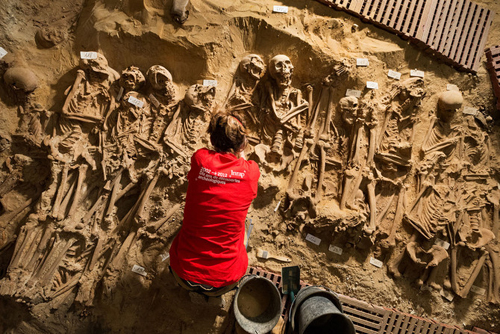Hundreds of medieval skeletons under the Paris supermarket
More than 200 bones were excavated in mass graves under a supermarket in Paris, which was once an ancient graveyard of Trinity Hospital in the 13th century.
So far, archaeologists have discovered about 8 burial pits. 7 burial holes from 5 to 20 people, while the remaining pit buried more than 150 people. All have no clear signs of injury or disease. The skeleton is lined up vertically from the head to the foot.

Collective bunkers more than 150 people were found at the scene.(Photo: Live Science)
Although the exact causes of these deaths are not known, the remains can help discover how the Chinese buried their dead in famine or disease, the researchers said.
To follow up, the team plans to use carbon radioisotopes to estimate when these people live. By combining this data with medieval Paris texts and maps, researchers hope to find out the cause and the time of these deaths.
According to Live Science, mass graves were discovered during the repair of the basement of the Monoprix Metroa-Siberastopol, Paris. When workers dig up the foundation, they discover many remains of men, women and children neatly arranged.
The scene used to be the base of Trinity Hospital, founded in 1202 by two German nobles. In 1353, when the "Black Death" pandemic raged, the hospital opened a cemetery, providing additional services for hospital operators at the time.
During the disastrous pandemic, hundreds of people died each day in the Hôtel-Dieu de Paris - the city's oldest hospital, and it was difficult to find enough burial places in this crowded city. Occasionally, bodies were buried in the Trinity hospital cemetery.
In the 1500s, Trinity Hospital was transformed into an apprenticeship for young children. By the 1700s, this place began to fail. During the French Revolution, the hospital was destroyed, the remaining buildings were turned into animal sheds.
- Excavating 92 medieval skeletons in the English church
- Excavation of 400 intact medieval skeletons underground
- The Chinese maiden was cremated because she suspected of being a witch
- 8 techniques of
- There is a cemetery hundreds of kilometers underground in Paris
- Discover the harsh medieval life
- Mysterious decoding 10,000 13th century skeletons in London
- Accurate prediction of the tragedy in Paris
- Hundreds of years old turned on the original reveal the medieval remains
- Close-up of Paris city
- Close up of weird red skeletons in the Milky Way galaxy
- The beauty of Paris through a bunch of photos taken over 100 years ago
 Discovered an ancient centipede fossil 99 million years old
Discovered an ancient centipede fossil 99 million years old Discovered bat-like dinosaurs in China
Discovered bat-like dinosaurs in China Discovered a 200-year-old bronze cannon of the coast
Discovered a 200-year-old bronze cannon of the coast Discover 305 million-year-old spider fossils
Discover 305 million-year-old spider fossils